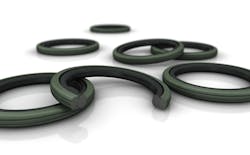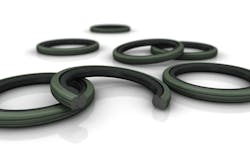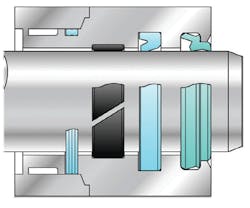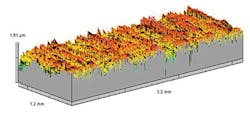The Do's and Don'ts of Seal Engineering
This file type includes high resolution graphics and schematics when applicapable.
Seals directly impact equipment performance. Used properly, they prevent fluid leaks, extend cylinder life, minimize friction and energy consumption, and improve actuator positioning accuracy.
In this two-part article series, we examine a dozen critical factors that influence how seals perform in various applications, offer advice on engineering best (and worst) practices, and review important considerations when testing seals and interpreting results.
It is important that engineers consider all 12 factors when selecting seals and testing them to validate performance. Although the prospect may seem daunting, practical experience with many of these factors helps engineers avoid common mistakes and replicate proven successes. Depending on the application, some are more applicable than others. Here are the do’s and don’ts engineers should keep in mind when looking for the best seal performance.
Pressure
Seals require pressure to function. Keep in mind pressure can deform seals and change the fluid film on which the seal rides.
Do:
- Consider pressure rise-rate effects. Rapidly rising pressure can introduce the potential for blow-by, where fluid bypasses the seal.
- Consider that a change in pressure affects the fluid film. The film gets thinner at higher pressures.
- Account for potential pressure spikes from valves, plumbing, and other sources.
- Bear in mind the role of pressure in relation to the dynamic profile. Pressure conditions can significantly differ during various motion sequences.
Don’t:
- Underestimate hardware ballooning or internal deformations caused by pressure. Changes to the mating hardware can severely affect seal performance.
- Misjudge the effect pressure can have on internal contamination. Higher pressures give contaminants more momentum and accelerate wear and debris generation.
- Concentrate testing only on pressure spikes, or only at high system pressure. Pressure energizes seals, and a sealing system may not energize properly at low pressure.
- Assume that test pressure is exactly the same as application pressure.
Load
The sealing system must absorb loads or forces to properly guide the piston or rod. When possible, incorporate bearings or wear rings to handle the majority of the load and limit rod or piston deflection.
Do:
- Understand that for localized tests duplicating only a section of a machine, engineers may need to transform load to displacement. Because of the size difference between test rig and actual application, isolated tests cannot simulate the particular load applied to the wear ring.
- Be aware that the scarf cut on wear rings works better on the unloaded side of the bearing. This ensures maximum material coverage and subsequent load distribution by the wear ring.
Don’t:
- Neglect impact. Impact conditions can exert extremely high loads on wear surfaces, which may be beyond the limits of some materials.
Speed
Speed plays a significant role in many applications. Changes to duty cycle, motion parameters, and accelerations all can significantly improve or degrade seal performance.
- Do:
- Understand that changes in the operating cycle, such as in linear cycling, can introduce different failure modes. For example, a system with slow rod extension and fast retraction performs differently compared to a system with fast extension and slow retraction. The latter is more susceptible to interseal pressure trap. In this case, a special seal (such as a Turcon Stepseal V, instead of a standard Stepseal) may be required to reduce pressure buildup between seals.
- Be aware that speed has a significant effect on fluid-film thickness and, therefore, on sealing effectiveness, leakage, friction, and wear. Leaks can increase as velocities decrease.
Don’t:
- Neglect the fact that speed can significantly change fluid properties. Elevated temperatures, viscosity breakdown, and chemical separation and degradation are all associated with higher speeds, and they often result in premature failure.
Dynamics
System dynamics go beyond general operating parameters and encompass other factors such as vibration, deformation, and alignment, which can worsen sealing capabilities.
Do:
- Know that vibration can significantly affect seal performance. Some materials have better dynamic properties than others and allow for better shaft tracking.
- Understand that offset or misalignment has a major impact on seals. Offset puts higher localized stress on sealing components and limits life. Bearings help ensure better alignment and longer seal life.
Don’t:
- Underestimate the effects of pressure “hold” conditions. Constant high pressure can cause material creep, which prematurely deforms sealing components and limits effectiveness.
- Ignore issues associated with impact, buckling, and similar dynamic events. Conditions caused by instantaneous reactions or instability are often difficult to replicate, or become a significant source of test-data noise.
Temperature
Seal temperature is not only due to outside environmental conditions and fluid movement through valves and hoses, but also due to frictional heat generated by seal operation.
Do:
- Account for frictional heating. It may significantly increase temperature near the seal.
- Keep in mind that high temperatures weaken seal and bearing materials, permit greater deformation and, thus, change performance.
- Remember that temperature cycling can affect a material’s temperature limits. For example, extended durations at high temperatures may decrease an elastomer’s low-temperature effectiveness.
Don’t
- Test seals at temperatures above the component’s limits. It can possibly cause severe premature aging of the seals and failure modes not experienced in the application.
- Underestimate temperature rise due to equipment shutdown. Lack of fluid flow immediately after shutdown sometimes raises temperatures beyond the capability of the seal material.
- Exceed fluid-temperature limits. This breaks down the fluid film under the seal, which increases friction and wear.
Time
Seals and bearings are highly stressed components that have finite life spans. Thus, time affects performance. Ideally components function consistently both at initial start-up and after many hours of use.
Do:
- Understand that seals and bearings have a time component associated with them. Elastomers tend to stress relax while plastics tend to creep or cold flow. Stress relaxation eventually reduces the force a seal exerts against the sealing surface. Creep is an increase in deformation or strain over time under a constant load/stress.
- Understand the working fluid and how its properties potentially change over time. Fluid aging and breakdown could change heat-transfer rates, lower viscosity, or alter the fluid’s chemical makeup and make it more aggressive to seal materials.
Don’t:
- Underestimate the effects of component fatigue. Fatigue of seals and bearings goes beyond cyclic operation. Because seals and bearings interact with mating components, fatigue may break down fluid or change shaft hardness, coatings, or component layout.
- Undervalue the fact that surfaces in contact with seals can change over time. Corrosion, fatigue, and other factors could significantly hamper sealing.
Proper assembly is obviously needed from a functional standpoint. It’s also needed for practical reasons, such as enabling volume production or easy field installation. Studies have repeatedly proven that premature seal failure most often results from installation errors.
Do:
- Use recommended assembly techniques and hardware when installing seals and bearings. The proper chamfers, radius edges, and resizing and installation tools help, along with avoiding sharp corners.
- Be careful installing seals over ports. Proper orientation, such as avoiding a cut seal section over the port, will reduce assembly damage. Also the seal cross section must be larger than the port to limit potential damage.
- Account for potential field assembly issues, as these often differ from factory installation. Simple changes may be needed to facilitate field assembly. Cut piston bearings, for example, are generally easier to install and keep in the groove. In comparison, installing rod bearings and inserting the shaft can be difficult.
- Consider accessibility. Some configurations house seals and bearings deep within a cylinder. Likewise, space for manipulating a seal into the groove does not exist in real applications, and the resulting distortion can be significant. In some cases, stiff seals and bearings must be heated to soften the material and let them be distorted for installation.
- Ensure assembly lubricant is compatible with seals and system components. Some installation lubricants can dry and cause seals to stick to the shaft, leading to high friction or seal twisting.
Don’t:
- Underestimate the effects of rapid stretch on sealing components. Although ASTM specs might indicate 100% elongation for a material, do not assume this is possible within an inordinately short time. High-speed installation increases the possibility of cracking, fracture, or permanent deformation.
- Underestimate the effect scaling — moving up or down in size — has on the effort required for seal assembly. Larger seals can require substantially more force.
- Dismiss the difference between seals built for stock and those built for immediate use. Sitting on the shelf can lead to failure modes not typically seen in the application, once they’re put to use. These can include:
Corrosion. Components normally covered by a protective lubricant may dry out or corrode due to improper storage.
Localized compression set. Storage conditions different than operating conditions may allow for high, localized seal compression due to the weight of the shaft.
Erratic start-up motion. Storage may let lubricant dry or squeeze out from under the seal lip. During start-up, this may cause localized high friction or, at the worst, seal twisting.
Media
Media refers to both retained fluid and external contamination the seal excludes.
Do:
- Understand fluid incompatibilities often lead to chemical attack on sealing components that increases friction and accelerates wear.
- Understand all potential sources of contamination. For example, water ingression may increase hydrolysis, which greatly affects certain seal materials. Even excessive air intrusion might significantly alter performance.
Don’t:
- Underestimate the importance of fluid cleanliness. Contamination can increase wear, abrasion, and impact damage to seals and also affects the fluid film under the seal.
- Ignore the effect of energy density and size. As energy density increases in some circuits, contaminants have more momentum and do more damage.
- Ignore fluid replenishment or replacement. This could affect fluid properties. And tests run using fluids different from those in the actual application often result in erroneous conclusions.
Mating surfaces
The sealing-bearing interface, including the mating materials and their surface finishes, is particularly important in dynamic seals that ride on a fluid film.
Do:
- Understand that various surfaces have different properties that affect fluid retention under the seal and, thus, wear and friction.
- Understand that changes to finishing processes can also change the resulting surface finish, and seal and bearing performance.
Don’t:
- Underestimate the importance of surface finish recommendations from seal suppliers, as optimal seal performance depends on the right balance of friction, wear, and leakage.
- Underestimate the effects of any change to mating surfaces.
Process
Process includes manufacturing, assembly, inspection, and other steps needed to produce seal and bearing components.
Do:
- Realize that some geometries have process/material limitations due to size or part complexity.
- Understand that the manufacturing method sometimes makes a significant difference in seal and bearing performance. Examples include molding versus machining of dynamic seal lips or composite bearings.
Don’t:
- Make significant process changes between prototypes and final production.
- Ignore the importance of all process and handling steps. A problem at any production step could significantly alter factors that critically affect sealing performance.
Design
Design is the specific geometry of seals and bearings.
Do:
- Understand the importance of working with seal suppliers to determine the right sealing system. The specific geometry, material, and layout of a sealing system depend on a variety of factors and their relative importance in an application.
- Understand the design limits of some geometries, depending on the manufacturing method.
Don’t:
- Assume that scaling geometry (linear change in dimensions) will equate to linear changes in friction, life, and leakage of the sealing system.
- Change component layout (location, spacing, and orientation of and between elements) without first considering the possible effects. For example, changes in spacing can significantly affect the heat transfer and pressure buildup between system elements. Another example is repositioning bearings which, in turn, alters seal deflection.
Materials
Materials make up the structure of seals and bearings.
Do:
- Understand that different materials perform differently, even in seals or bearings with the same geometry. Some materials simply work better in certain applications.
- Carefully consider the risks and rewards when substituting new materials for seals, bearings, and mating surfaces, as well as when changing fluids.
Don’t:
- Underestimate the value of sealing and bearing materials. There are special materials in which typical specifications, such as ASTM callouts, cannot fully describe the benefits.
- Underestimate the influence of materials on the seal/bearing/fluid/dynamic sealing surface. Many seals work using transfer films, exposed fillers, reduction of peaks on dynamic surfaces, and other mechanisms.
Taking into account the 12 critical elements that determine how seals function — prior to purchasing parts and investing time and money in testing and validation — helps optimize both seal performance and return on investment. When in doubt, seek the assistance of a reputable seal supplier’s application engineers.
Resources:
Trelleborg Sealing Solutions, www.tss.trelleborg.com/us
B. Gupta and L. Castleman, “Viscoelastic Effect on the Performance of Elastomeric and Plastic Seals by FEA,” Proceedings of the 51st National Conference on Fluid Power, March 2008.
H. Jordan, “Alternative Surfaces (Coatings and Treatment) in Hydraulic Cylinders,” Proceedings of 12 International Sealing Conference, September 2002.
More on Seal Validation
The second article in this series, "Examining Seal Validation Strategies," looks at important considerations when testing seals and interpreting results. Confirming that a sealing system works as intended is an important part of the overall equipment validation process. The article can be found at http://machinedesign.com.





